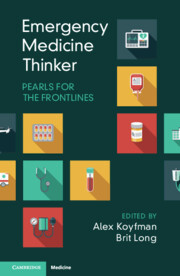Book contents
- Emergency Medicine Thinker
- Emergency Medicine Thinker
- Copyright page
- Contents
- Contributors
- Introduction
- Section 1 Decision-Making
- 1 On Deciding to Not Decide
- 2 What Makes Emergency Medicine Decision-Making Unique and Why?
- 3 Pediatric Emergency Medicine Approach: Be Vigilant but Be Reasonable
- 4 Decision-Making in Emergency Medicine
- 5 Emergency Medicine Medical Decision-Making
- 6 Decisions
- 7 Emergency Thinking and Behavior
- 8 Emergency Medicine Decision-Making
- 9 Emergency Medicine Decision-Making
- 10 Emergency Medicine Thinking and Cognitive Load Considerations
- 11 Decision-Making in Uncertainty
- 12 Unlearning and Thinking Differently
- 13 Decision-Making in Emergency Medicine
- 14 An Object in Motion
- 15 Too Little or Too Much?
- 16 Decision-Making in Emergency Medicine
- 17 Medical Decision-Making in the Emergency Department: Balancing the Patient’s Health with the Clinician’s Perception of Risk
- Section 2 Clinical Pearls
- Index
2 - What Makes Emergency Medicine Decision-Making Unique and Why?
from Section 1 - Decision-Making
Published online by Cambridge University Press: 14 March 2025
- Emergency Medicine Thinker
- Emergency Medicine Thinker
- Copyright page
- Contents
- Contributors
- Introduction
- Section 1 Decision-Making
- 1 On Deciding to Not Decide
- 2 What Makes Emergency Medicine Decision-Making Unique and Why?
- 3 Pediatric Emergency Medicine Approach: Be Vigilant but Be Reasonable
- 4 Decision-Making in Emergency Medicine
- 5 Emergency Medicine Medical Decision-Making
- 6 Decisions
- 7 Emergency Thinking and Behavior
- 8 Emergency Medicine Decision-Making
- 9 Emergency Medicine Decision-Making
- 10 Emergency Medicine Thinking and Cognitive Load Considerations
- 11 Decision-Making in Uncertainty
- 12 Unlearning and Thinking Differently
- 13 Decision-Making in Emergency Medicine
- 14 An Object in Motion
- 15 Too Little or Too Much?
- 16 Decision-Making in Emergency Medicine
- 17 Medical Decision-Making in the Emergency Department: Balancing the Patient’s Health with the Clinician’s Perception of Risk
- Section 2 Clinical Pearls
- Index
Summary
There are few places like an Emergency Department. No length of formal training can completely prepare you. You will never have the depth nor breadth to know everything that you are required to know in order to care for the patients in front of you. Where would you find educational instructions on how to remove a metal water bottle that has been stuck on a patient for three days after he decided it was a good idea to insert both his testicles and penis in the narrow-rimmed opening? No textbook details this type of removal. The training includes specifics of “if x then y,” so there are clinical algorithms to learn and apply. But you also learn very quickly that patients rarely fit very neatly into little boxes and clearly in pathways. Rather, they are complicated. They have comorbidities, coexisting significant diseases that impact treatment plans. They fit in the algorithm to anticoagulate for their cardiac condition, but they have an alcohol use disorder and are at risk of intoxication-related falls. They meet criteria for replantation but have to get back to work to support their family so prefer the revision amputation. The examples are endless and perhaps more common than the textbook norm.
- Type
- Chapter
- Information
- Emergency Medicine ThinkerPearls for the Frontlines, pp. 13 - 20Publisher: Cambridge University PressPrint publication year: 2025

